Related Research Articles

The Mariner program was conducted by the American space agency NASA to explore other planets. Between 1962 and late 1973, NASA's Jet Propulsion Laboratory (JPL) designed and built 10 robotic interplanetary probes named Mariner to explore the inner Solar System – visiting the planets Venus, Mars and Mercury for the first time, and returning to Venus and Mars for additional close observations.
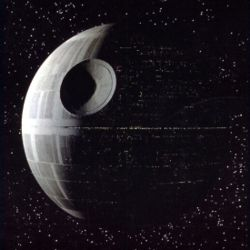
The Death Star is a fictional space station and superweapon featured in the Star Wars space-opera franchise. Constructed by the autocratic Galactic Empire, the Death Star is capable of obliterating entire planets, and serves to enforce the Empire's reign of terror. Appearing in the original 1977 film Star Wars, the Death Star serves as the central plot point and setting for the film, and is destroyed in an assault by the Rebel Alliance during the climax of the film, with the 2016 prequel film Rogue One and the 2022 television series Andor exploring its construction. A larger second Death Star is being built in the events of the 1983 film Return of the Jedi, featuring substantially improved capabilities compared to its predecessor, before it is destroyed by the Rebel Alliance while under construction.
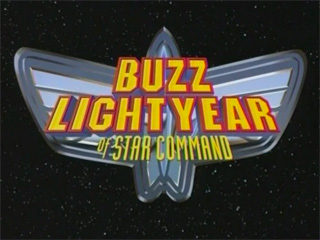
Buzz Lightyear of Star Command is an American animated science fiction comedy television series produced by Walt Disney Television Animation and co-produced by Pixar Animation Studios. It serves as a spin-off of the Toy Story franchise and presents a fictionalized account of the in-universe character Buzz Lightyear. The series was preceded by the direct-to-video film Buzz Lightyear of Star Command: The Adventure Begins, and aired on UPN and ABC from October 2, 2000, to January 13, 2001, as part of Disney's One Saturday Morning and Disney's One Too programming blocks. While the series is 2D animated, Pixar animated the CGI opening title sequence at the beginning of each episode. The program was animated by Walt Disney Animation Japan, Tama Productions, Sunwoo Entertainment, Sunmin Image Pictures, Sae Hahn Productions, Hana Animation, Jade Animation, Wang Film Productions and Toon City.

Mage Knight is a miniatures wargame using collectible figures, created by WizKids, Inc, and is the earliest example of what is now known as a collectible miniatures game. The game was designed by founder Jordan Weisman along with Kevin Barrett. The game is the first to use WizKids' Clix system, combining roleplaying and wargaming elements with aspects of collectible card games. Mage Knight achieved success after it was introduced in 2000.
NECA/WizKids, LLC is an American company based in New Jersey that produces tabletop games. WizKids is best known for its collectible miniatures games (CMGs) Mage Knight, HeroClix, MechWarrior, and HorrorClix, all of which make use of the company's Clix system, in which the changing combat statistics and abilities of each figure were indicated by a turnable dial inside the base underneath the figure. The company was founded in 2000 by Jordan Weisman, a veteran of the game company FASA. It was purchased by sports-card manufacturer Topps, Inc. in 2003.
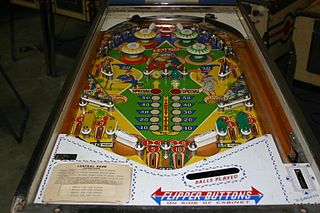
Gottlieb was an American arcade game corporation based in Chicago, Illinois. It is best known for creating a vast line of pinball machines and arcade games throughout much of the 20th century.
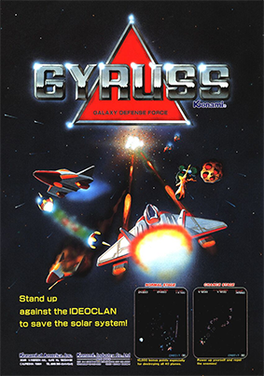
Gyruss is shoot 'em up arcade video game designed by Yoshiki Okamoto and released by Konami in 1983. Gyruss was initially licensed to Centuri in the United States for dedicated machines, before Konami released their own self-distributed conversion kits for the game. Parker Brothers released contemporary ports for home systems. An enhanced version for the Family Computer Disk System was released in 1988, which was released to the North American Nintendo Entertainment System in early 1989.
Vampire: The Eternal Struggle is a multiplayer collectible card game published by Wizards of the Coast (1994-1996), then White Wolf Publishing (1996-2010) and after several years of hiatus, by Black Chantry Productions (2018-present). It is set in the World of Darkness and is based on the Vampire: The Masquerade roleplaying game.
MechWarrior: Dark Age was a tabletop wargame by WizKids set in the BattleTech universe that uses the Clix system. The game's miniatures are pre-painted models of infantry squads, vehicles, and giant walking war machines known as BattleMechs or more simply "'mechs".

Jovian Chronicles is a science fiction game setting published by Dream Pod 9 since 1997. It introduces a complete universe for role-playing and wargaming space combat featuring mecha, giant spacecraft, and epic space battles.
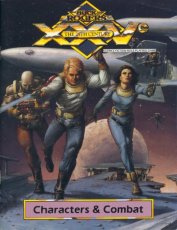
Buck Rogers XXVC is a game setting created by TSR, Inc. in the late 1980s. Products based on this setting include novels, graphic novels, a role-playing game (RPG), board game, and video games. The setting was active from 1988 until 1995.

Inconstant Moon is a science fiction short story collection by American author Larry Niven that was published in 1973. "Inconstant Moon" is also a 1971 short story that is included in the collection. The title refers to "O, swear not by the moon, th' inconstant moon", a quote from the balcony scene in William Shakespeare's Romeo and Juliet. The collection was assembled from the US collections The Shape of Space and All the Myriad Ways.

Buck Rogers: Countdown to Doomsday is a role-playing video game set in the Buck Rogers XXVC universe. It was published in 1990 by Strategic Simulations for MS-DOS, Commodore 64, and Amiga. A Sega Genesis version was released in 1991. Buck Rogers: Matrix Cubed is the 1992 sequel.

Mutant Chronicles is a pen-and-paper role-playing game set in a post-apocalyptic world, originally published in 1993. It has spawned a franchise of collectible card games, miniature wargames, video games, novels, comic books, and a film of the same title based on the game world.

Starship Catan is a two-player card game, loosely based on the Starfarers of Catan board game. As a member of the Catan family of games, it is designed by Klaus Teuber, and distributed by Kosmos in German and Mayfair Games in English.

Starfarers of Catan is a multiplayer board game loosely based on the Settlers of Catan series of games. It was created by Klaus Teuber as an official spin-off and is distributed by Kosmos in German and Mayfair Games in English.

Rocketmen: Axis of Evil is a downloadable top-down shooter created by Canadian indie developers A.C.R.O.N.Y.M. Games and Eyerisk Studios and published by Capcom for the PlayStation 3 and Xbox 360. The game is based on the constructible strategy game called Rocketmen from WizKids. It supports 1-4 person cooperative play either online or offline. The game was originally set for release in November 2007, but was delayed up to March 2008.
This page lists board and card games, wargames, miniatures games, and tabletop role-playing games published in 2012. For video games, see 2012 in video gaming.

Zarathrusta is a 1991 multidirectional shooter developed by Belgian video game developer The Whiz Kidz and published by Hewson Consultants for the Amiga. Written by Peter Verswyvelen and with graphics by Erlend Robaye, the game is inspired by the 1986 video game Thrust. Their goal was to create a 16-bit version of Thrust's gameplay, with more levels, enhanced graphics and improved features. The game's name is a portmanteau between "Zarathustra" and "Thrust".
References
- ↑ Kaufeld, John; Smith, Jeremy (2006). Trading Card Games For Dummies . John Wiley & Sons. ISBN 0470044071.
- ↑ "Origins Award Winners (2005)". Academy of Adventure Gaming Arts & Design. Archived from the original on 5 November 2007. Retrieved 30 October 2007.
- ↑ "Pyramid: Pyramid Review: Rocketmen: Axis of Evil".